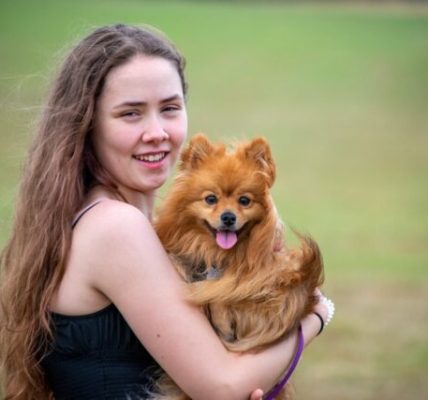Most of us know the harm that tools such as shock and prong collars can cause. But I worry that our focus on tools causes less dramatic aversive methods to go under the radar.
We do talk about some aversive methods not associated with tools. Things like molding, where a dog is forced into position. Scaring dogs with noises. Kicking or hitting. But you know what is discussed very little?
Extinction. Specifically, operant extinction of a positively reinforced behavior. An experience that can be so unpleasant to the learner it can provoke violence (Azrin et al., 1966) or depression (Huston et al., 2013; Ramnerö et al., 2016).
Here’s a definition:
The extinction operation is the discontinuation (cessation) of reinforcement as a consequence of a given behavior, leading to a decrease in the frequency of that behavior. — Mayer et al, 2018, p. 30.
A previously reinforced behavior yields—nothing. No consequence. The classic human example is a suddenly nonfunctional beverage or candy machine.
Tools such as shock and prong collars are used almost exclusively in positive punishment and negative reinforcement protocols. Extinction of a positively reinforced behavior is not an event associated with their normal use. But the experience of extinction can be anything from annoying to frustrating to devastating.
Extinction in Positive Reinforcement Contingencies
There are varying intensities, for lack of a better term, of extinction. When a trainer shapes behavior there will be episodes of extinction, in which a previously reinforced approximation is no longer reinforced. But the more skilled the trainer, the fewer and more uneventful these are. A good trainer makes it plain through the environmental setup and their actions what the dog should try next. I.e., how they can continue to access reinforcement with slight changes to their behavior.
Sometimes we train a new behavior to access the same or similar reinforcement as a problem behavior. No matter how kind and thoughtful we are, our goal is to extinguish the problem behavior in that context. But good planning and providing a clear path to reinforcement for the dog can help soften the experience.
But contrast these carefully designed plans with, for example, the commonly recommended method to ignore dogs who jump up without giving them any clue about what to do instead. Many people have discussed the inefficacy of this method, including me. But besides being ineffective, any abrupt change like that can be unkind. (Depending on how this plan is implemented, it very likely incorporates negative punishment as well.)
Alanna Lowry, DVM, and wonderful, “naughty” Flynn were hamming it up in the adjacent photo. But it is no fun for most dogs to have their human completely ignore them.
That’s the kind of extinction scenario I am focusing on in this discussion: a previously reinforced behavior that is no longer reinforced at all. A complete cessation of reinforcement with no alternative offered. The dog has no ability to remedy the situation, i.e., access that reinforcer again.
This happens not only in training, but in life.
Noting quickly: there also exists extinction of negatively reinforced behavior, so-called escape extinction. I may write about this in the future.
Theoretical Extinction Example
Here is an extreme example that I hope none of us would ever do. Let’s say that every evening you have a play session with your dog. You make several preparations for this. You may change your clothes. Perhaps you’ll grab some treats from a jar. You may get some special equipment and set it up.
You make all the preparations, grab your dog’s toy, and head for the play area. Your dog is accompanying you—excited and ready for some fun. You’ve started the familiar launch sequence. But when you get to the area where you normally play, instead of starting the play, you put the toy out of the dog’s reach and sit down and look at your phone. You ignore your dog.
It’s painful for me to even imagine this because of how hard it would be on my dog. He would try different things to engage me in play for a while. I would be able to see the effects of the extinction process in his behavior as his behavior began to vary. I would likely see frustration-related behaviors if I let it go on too long (Bentosela et al., 2008; Jakovcevic et al., 2013). In other words, fallout.
If I did that every day (completely stopped playing with him after setting up to do so), I wonder how long it would take before he stopped trying to play with me? Again, this is sad to think about.
What Extinction Can Look Like
In the photos below, Lewis’ Jolly Ball, a favorite toy, is hanging in the tree behind me. He is using a variety of behaviors to remedy the situation. This is typical of an extinction process, where the variability of behavior increases. It is a diluted extinction burst.
I call it diluted because was not a true extinction event. I cherrypicked the photos out of a quick 60-second video. I did not consistently ignore Lewis. I interacted with him between these shots, and I put some peanut butter on the tree to set up that shot. It was still excruciating for me to do, to slightly confuse him and to delay the fun for 60 seconds. Of course we played heartily with the Jolly Ball afterward.









There is a lay term for this activity: teasing. “Look! Here’s this thing you want but you can’t have it.”
It worries me that suddenly ceasing to reinforce a behavior that had been reinforced in the past would not break any stated guidelines about force free training I’ve seen. Although they are acknowledged as problematic in the Hierarchy of Behavior-Change Procedures and in the LIFE model, professional organizations don’t seem to cover them in their requirements and position statements and they are not a frequent topic of discussion for individual trainers.
We are technically not doing anything to the dog at all. Not touching him, not scolding him. Yet—it can be cruel.
Real-Life Extinction Example
I made that example extreme to focus on the potential harm. but this type of thing happens in smaller ways. It happens when we suddenly change routines. Here’s a real example from my life with Lewis.
Lewis eats most of his breakfast out of a food toy. But for several months, I broke up his breakfast period with a training session. He got to choose when to switch. I went in with a handful of 15–20 higher-value kibble pieces. I made myself available and waited for him to take a break (good matching law exercise), then we’d have a quickie training session. Then he went back to his food toy.
Over the months, I noticed that we had a hard time in those sessions. He was jumpy and mouthy. He seemed conflicted, likely because of having to leave one food source for another. Duration behaviors such as front-paws-on-a-platform, shown in the top and adjacent photos, were extra difficult. The adjacent photo is from one of those sessions; the top one was posed much later. See the difference?
I had done this mid-breakfast training with Clara before, but she was a different dog with a different history with me. She moseyed over to play with me, then moseyed back to her food toy. It took me way too long to perceive the negative experience for Lewis.
After I noticed, I decided to stop our mid-breakfast training session.
I put some thought about how to break our routine in the kindliest way possible. Even though the session seemed stressful, he would eagerly approach me when it was time and gobble the food. So he would notice its absence for sure.
What were the cues for this interruption? An obvious one was my entering the hallway where he eats. So if I stopped coming in, would he stop “expecting” the session? No. Another part of the cue was time. Not time of day, but the amount of time elapsed from when he started eating. Somewhere around four minutes. I could not prevent the passage of time. So I couldn’t prevent the little period of extinction where he would perform anticipatory and approach behaviors like looking up from his toy or coming to the gate where I would normally enter. Those were the behaviors that would no longer be reinforced if I ceased the mid-breakfast session.
Was this going to be grueling for him? Not likely. To anthropomorphize a bit, the human parallel would be something like, “Well, I guess we aren’t doing that anymore. Damn. I liked that food. Oh well, I’ve got this other food to work on.”
But making a plan and softening this change provided good practice for me to learn how to handle more intense extinction scenarios that might come along.
My Training Plan
Parts of the Cue (Predictors)
- Elapsed time
- My getting out the food (he could sometimes hear or see this)
- My approach with food
Lewis’ Behaviors in Response to the Cues
- Standing still (rather than interacting with his toy)
- Looking around
- Approaching the gate where I enter
Reinforcers
To eliminate the training session, I planned to fade the cues by softening them or moving them, and to decrease the amount of the special kibble (but not to zero).
Here are the steps I took.
- I substituted something else for the training session. I came in at the usual time and gave Lewis the special kibble in a floor scatter. Then I hung around for a while. I offered this social behavior because there was a social reinforcer included in the original activity. He likes having me around when he eats.
- I gradually decreased the amount of special kibble (but included the rest in his meal or in another training session).
- I gradually lengthened the amount of time before coming in.
My final behavior is to come in when he is about finished with his food toy (which I have always done anyway), hand him a couple of pieces of the special food, then help him retrieve any pieces of kibble he can’t get. This is part of our normal routine.
Why Bother?
My first example with the play session may have seemed overblown. And my example of fading the interruption in Lewis’ breakfast may seem insignificant.
But I want to practice thinking about this, working out the problems to prevent unpleasantness in my dog’s life. My thought processes will help me if something bigger comes along.
Conclusion
Whether it’s in training or in life, whether it’s planned or sudden and unavoidable, don’t ever forget about the hurt of extinction. If it’s necessary to discontinue a regular activity your dog enjoys, soften the blow in any way you can. And if you have a training credential, ask your accrediting body whether extinction without differential reinforcement is worth addressing in guidelines and position statements.
What kinds of extinction scenarios have you noticed with your dog, either in training or daily life? What happens when there is a cue for a behavior and there is no reinforcement available for that behavior anymore? This can include some very sad scenarios, such as a breakup or a death in the family. (In the future, I hope to write more about the loss of Clara. It hit Lewis hard.) But there are so many less intense things that happen: schedule changes and the like. How does your dog handle them? How do you help your dog?
References
Azrin, N. H., Hutchinson, R. R., & Hake, D. F. (1966). Extinction‐induced aggression. Journal of the Experimental Analysis of behavior, 9(3), 191-204.
Bentosela, M., Barrera, G., Jakovcevic, A., Elgier, A. M., & Mustaca, A. E. (2008). Effect of reinforcement, reinforcer omission and extinction on a communicative response in domestic dogs (Canis familiaris). Behavioural processes, 78(3), 464-469.
Huston, J. P., de Souza Silva, M. A., Komorowski, M., Schulz, D., & Topic, B. (2013). Animal models of extinction-induced depression: loss of reward and its consequences. Neuroscience & Biobehavioral Reviews, 37(9), 2059-2070.
Jakovcevic, A., Elgier, A. M., Mustaca, A. E., & Bentosela, M. (2013). Frustration behaviors in domestic dogs. Journal of applied animal welfare science, 16(1), 19-34.
Mayer, G. R., Sulzer-Azaroff, B., & Wallace, M. (2018). Behavior analysis for lasting change, fourth edition. Sloan.
Ramnerö, J., Folke, F., & Kanter, J. W. (2016). A learning theory account of depression. Scandinavian journal of psychology, 57(1), 73-82.
Related Posts
Copyright 2024 Eileen Anderson










